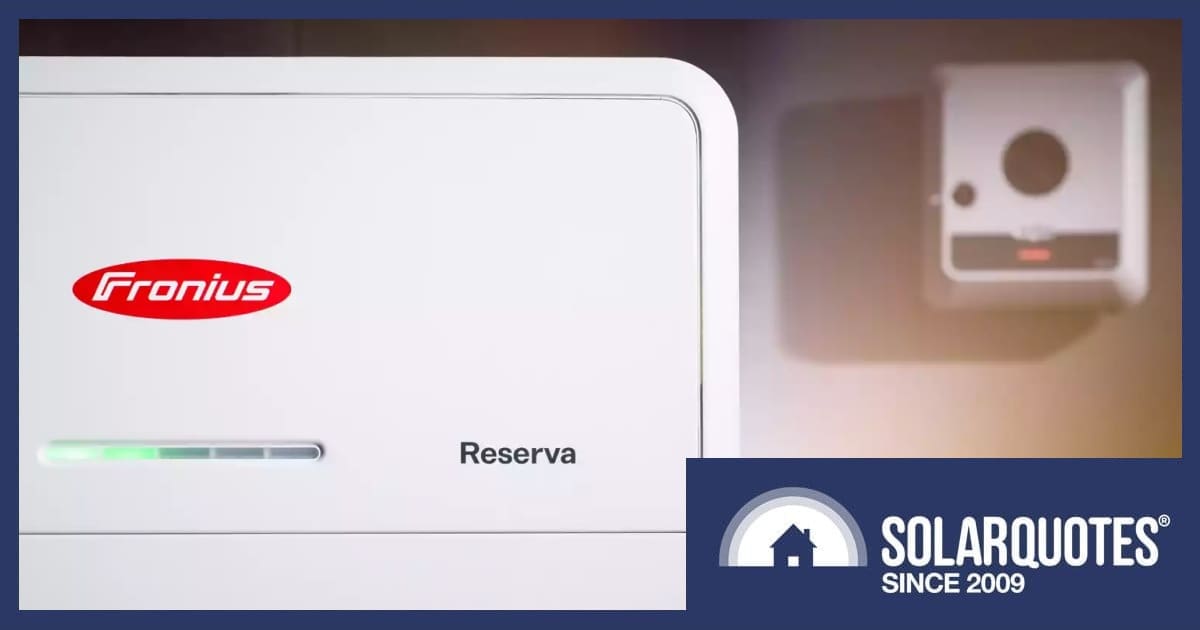It’s been a while between drinks, but Austria’s Fronius is back in the home battery manufacturing game. Here’s a first look at the Reserva.
Fronius is best known for its inverters, but the company once offered a home energy storage system called the Fronius Solar Battery.
The base model was 4.5kWh, but could be expanded to as much as 12kWh capacity (9.6kWh usable), and offered a 4kW continuous power rating at the 12kWh configuration. It wasn’t cheap (“reassuringly expensive” as SQ’s Anthony would say), could only be installed indoors and used for three-phase homes. Given its limitations, it didn’t come as a great surprise when the company stopped offering it.
Fronius Reserva Unveiled
Officially launched last week, the Fronius Reserva is a DC-coupled high-voltage battery offering usable capacities of between 6.3 kWh and 15.8 kWh. The base unit is expanded by adding up to 5 stackable modules of 3.15kWh each. The cells in the modules are lithium iron phosphate (LFP/LiFeO4) chemistry. Up to four battery towers (aka “stacks”) can be connected in parallel to achieve a maximum storage capacity of 63 kWh.
Unlike the Fronius Solar Battery, the Reserva can also be used for a single-phase home and is compatible with Fronius hybrid inverters such as the Symo/Primo GEN24 Plus, but not the Symo Hybrid. The compatibility chart here indicates the Primo GEN24 Plus (single-phase) is only compatible with Reserva 6.3 and 9.5; whereas the Symo GEN24 Plus (three-phase) is through to the 15.8.
The company says the Reserva is backup power and black start capable. A Fronius Backup Controller and Backup Switch is needed to enable automatic backup power switching.
The Reserva has an IP65 ingress rating, which means it can be installed outside (in “protected areas”) as well as indoors . The system has an operating temperature range of -20 C to 55 C. Dimensions range from 860 x 780 x 176 mm – 1,610 x 780 x 176 mm depending on the number of modules in a tower; so it’s quite a slim battery. Weights range from 85 kg to 187 kg.
As for country of manufacture, that’s not specified on the datasheet, brochure or website landing page. Usually Fronius gear is made in Austria, but that doesn’t necessarily mean it’s the case with the Reserva.
Monitoring of the Reserva is via Fronius Solar.web where all Fronius device monitoring is displayed. The company says data is stored exclusively on European servers, which is meant to reassure those who are particularly concerned with data being stored …elsewhere.
A Longer Warranty
The company’s original battery only had a 5-year warranty, whereas with the Reserva it’s 10 years.
According to Fronius CSO Harald Scherleitner:
“Longevity is particularly important to us at Fronius. We therefore guarantee that the Fronius Reserva will still deliver at least 80 percent of its usable energy after ten years from the start of the warranty.”
I haven’t seen a warranty document yet to check out the finer details, but 80% at the end of year 10 is pretty good; with many manufacturers only warrantying 60% – 70%.
I’ve asked Fronius if/when the Reserva will be available in Australia and will update this post when there’s further information. Approximate pricing isn’t known – but keeping in with Fronius tradition, the Reserva battery will likely also be “reassuringly expensive”.
—
Update: July 21, 2025: In early July, Fronius announced the Reserva should be ready and available for installation in Australia from October this year.
—
I like Fronius gear and have a Primo SnapInverter (being phased out) and a Wattpilot EV charger. They do what it says on the tin, and reliably. While I didn’t experience any “wow” when reading about the Reserva, based on the company’s track record over the last decade it’s not unreasonable to suggest it should be the same.
The Reserva isn’t the only battery compatible with Fronius’s hybrid inverters. For example, there’s also BYD’s Battery-Box Premium HVS/HVM; although the HVS series no longer appears to be available.


 RSS - Posts
RSS - Posts



There appears to be a webinar scheduled for 13th March where, perhaps, you can get more answers?
https://www.fronius.com/en/solar-energy/installers-partners/infocentre/events/webinar-en-reserva-13032025
Date 3/13/2025
Address Online
Duration 9:00 AM – 09:30 AM CET
Language English
Costs Free of charge
What’s Fronius market share now? I have a feeling they will be wiped off the market in the next few years by the likes of Sungrow, BYd, Goodwe, Alpha to name a few.
Hi Sonia,
Fronius are pretty solid, they offer *great* support for a product that’s properly developed.
They don’t shove stuff out and use the customers to do field testing.
They are leaders with flexible grid integration.
They are proper first world quality which also appeals to those who are dubious about their data being hosted & harvested in China.
They’re not as busy as they were when they took the #1 mantle from SMA, but I can’t seem them going anywhere.
Shame about the limited capacity with single phase systems. I have a Primo GEN 24 and am in the market for a battery, but it looks like it’ll have to be BYD HVM or LG FLEX if I want more than 9.5 kWh.
Seems a strange limitation, what could the technical reason be or is it just gate-keeping?
You can stack 9.5 side by side in parallel up to 5 stacks. We have 13.3kW on the roof and will stack 2 x 9.5 Reservas for 19 kWh of back up and night use. Not bad for $13,500.
That limit of only the 6.3 or 9.5 kW.h models with single-phase (Primo) inverters is a real bummer, but it’s because the Primo’s DC battery voltage range has to be between 150-455 V DC, unlike the 2 PV/MPTT inputs which are 65-600 V DC. The 12.6 & 15.8 kW.h models exceed that battery DC voltage limit.
mg-solar-shop (German) is listing all the options with prices, including 19% German VAT rate:
6.3: €3,594.56
9.5: €4,821.74
12.6: €6,048.91
15.8: €7,276.09
Individual 3.15 kW.h module (no BMS): €1,227.18
For Australians, if you subtract Germany’s 19% VAT then add international shipping to AU, it’s probably a wash, but then add 10% GST 🙁
It works out to about €480 / kW.h, which is, well, better than it’s ever been for big-brand-name home-batteries, but when you then convert to AUD it’s still an eye-watering AUD$826/kW.h.
And these prices don’t include any of the Fronius switch-gear to get isolated backup operation, nor supplier installation…
Does anyone know how fast it will kick in in case of a blackout?
Hi Zak,
Currently the Gen24 inverters are down to about 15 seconds I believe.
Think of it as a big, unmissable analogue warning signal that there’s been an outage & you need to be modest with your consumption.
If you require UPS for a computer or something then a solar inverter really isn’t good enough. Even those claiming millisecond response times will shut down & reset if they’re exporting a lot (and the battery is already at 80%+) when the grid outage occurs
Any word on whether this product is coming to Australia? If so, pricing detail?
Also interested in when they may be available in Australia
Why wouldn’t the Primo be compatible with the larger battery stacks? Seems odd, with a 5kw Primo Gen24 I think it ‘supports’ up to a 19kw BYD battery. Hoping the support for the larger units is there and the reason it’s not explicitly stated is because it’s only able to charge/discharge at a limited rate.
Chris, pls see my reply back on March 8th, it’s to do with the relatively low maximum-Voltage spec of the Primo’s DC battery input. There’s no hard n fast rules here. It’s the combination of (a) individual cell capacity (Amp.hours, A.h) and (b) the number of cells in series needed to achieve some specific voltage range, and the multiplication of the two (cell voltage x cell A.h-capacity) that results in the overall battery pack being X kW.hours.
For whatever reason, Fronius appear, I suspect, to have put in smaller capacity cells, and probably the same/similar number of cells in series, compared to BYD’s Fronius-compatible batteries, and so only the 2 smaller capacity stacks will work with Primo; for higher capacity you need the Symo which (IIRC) has a higher DC battery input max-voltage spec.
It’s very disappointing.
Makes me want to rip out my Fronius setup. Too expensive but the Sigenstore for Sigenergy might be an option for me one day. I’ve got two Fronius inverters at the moment with 3-4 stings of panels. The Sigenstore looks to support up to 4 mpp trackers so I could go from two inverters to one, includes significant battery capacity and also bidirectional EV charging (when it gets updated/released etc). Need to upgrade to three phase first though…
Hi Chris,
Be aware; if your original solar has parallel arrays and takes advantage of the really heavy current ratings of Fronius (up to 33Amps on some) then a Sigenergy won’t handle that.
Sig tops out at 16A so they don’t handle more than a single string per input & the wiring might be impossible to rearrange.